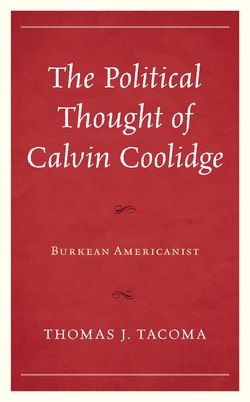Читать книгу The Political Thought of Calvin Coolidge - Thomas J. Tacoma - Страница 13
На сайте Литреса книга снята с продажи.
Pre-Conditions of Progressivism: Economic and Cultural Developments
ОглавлениеIdeology alone does not make a social reform movement successful. The Progressives were reacting against what they believed were grave injustices in the public order. Their major concerns included the destabilizing impact of industrialism, the contentious relations between labor and capital, child labor, the growth of an uncertain global market, the emergence of enormous and powerful corporations, and other economic factors. Politically, Progressive reformers abhorred the corruption they believed rampant in the two major political parties, particularly the problems of big business bribing state legislators and through them controlling the U.S. Senate. Added to this mix was the closing of the American frontier, the rapid influx of millions of immigrants from new regions of Europe, and the surging growth of American cities. In short, tremendous economic and cultural change challenged the nation in a way that broadened the appeal of new ideas and social philosophies.
Postbellum America entered what Mark Twain called the “Gilded Age.”[8] As narrated by many historians, this was the era of growth in industry, expansion of railroads, and concentration of wealth in the hands of the few and mighty. Americans were greedy, life was sordid, and politics was the province of corrupt dealmakers. This story of sharp relief between the rich and poor, embraced by Progressive reformers, carried great political weight. Historian Michael McGerr contrasts the lives of the wealthy with the uncertain circumstances of the poor, writing:
Wealthy capitalists, manufacturers, merchants, landowners, executives, professionals, and their families made up not “ten,” but only 1 or 2 percent of the population. These were the people who owned the majority of the nation’s resources and expected to make the majority of its key decisions. . . . Their most visible and powerful members were the two hundred or so families worth at least $20 million, fortunes with few parallels in history.[9]
Juxtaposed against such wealth and power was the plight of the hardworking poor: “All of them, even the best-paid skilled workers, lived circumscribed, vulnerable lives, constrained by low pay and limited opportunity, and menaced by unemployment, ill health, and premature death.”[10] Occupational differences mattered little for those at the bottom. Whether in agriculture or factory work, the fact of life was material poverty. Even farmers, though free from the artificial timetables of the factory and its whistles and machinery, were subject to competition in international markets that they did not understand and to global downturns no one could predict or control.[11]
In this traditional telling, class conflict and the growth of class consciousness mark the beginning of the Progressive era. Major railroad strikes in 1877, 1886, and 1894 taught even the middle and upper classes that something was wrong. Strikes across different industries—in mining, in manufacture, and in transportation—revealed to respectable Americans that the old system of individualism and the self-made man was breaking down.[12] In addition, a major factor in the new uncertainty over the economy was the closing of the American frontier. By the 1890s, most available farmland had been bought up. The option of packing up and moving west was gone. Superadded to the plight of the farmer were the fluctuations in the prices of their goods and the economic depressions they endured. The Depression of 1893 was particularly severe, and President Grover Cleveland’s refusal to bring government action to relieve distress seemed to reveal the emptiness of the old laissez-faire ideology.[13]
To the immigrant families crowded into an urban slum, life consisted of work and hardship. As millions of immigrants poured into American cities from Italy, Russia, and elsewhere in southern and eastern Europe, city leaders felt overwhelmed with the prospect of providing proper utilities and maintaining healthy living conditions for them. Speakers of foreign languages and worshippers in unfamiliar faiths introduced an alien element into American society. Party bosses at the ward level took immigrant populations under wing, but this too was taken to be symptomatic of the era’s political corruption.[14]
Other issues also loomed large for American reformers. Beyond economic dislocations, political corruption and inefficiency, and urban distress, Americans worried about growing problems such as alcoholism and the need for temperance. Others agitated for women’s suffrage. More and more citizens were concerned about the need for greater education, especially among communities of immigrant children. Something in American society was amiss, and the Progressive movement emerged to confront the full spectrum of social ills.
